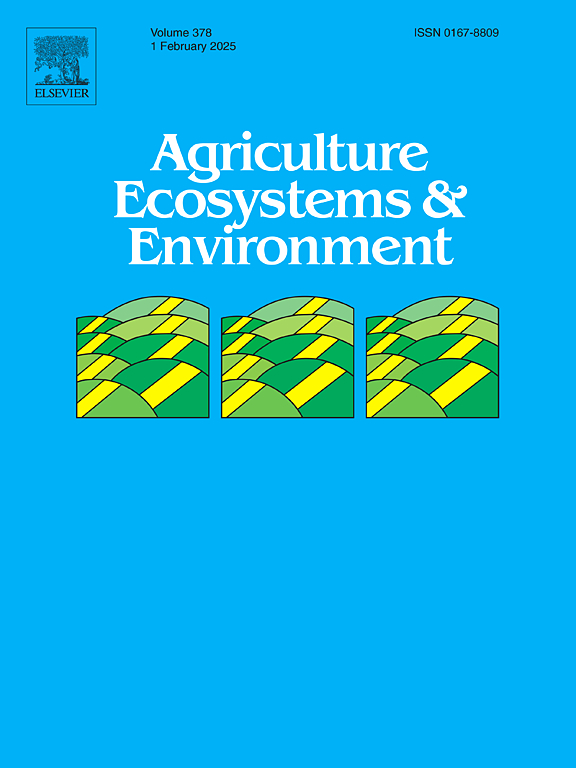Are rice fields less diverse and more invaded by non-native species than less impacted habitats? A test with wetland microcrustaceans
IF 6
1区 农林科学
Q1 AGRICULTURE, MULTIDISCIPLINARY
引用次数: 0
Abstract
Freshwater ecosystems are subject to multiple human stressors, which can make them more susceptible to invasions. Even protected areas established to safeguard freshwater wetlands can be vulnerable to invasions, particularly when they include disturbed environments such as rice fields, which function as colonization pathways for invasive aquatic organisms. In this study, we compared the microcrustacean communities across three habitat types (rice fields, marshes and limnocrenes) in two protected Mediterranean wetlands during summer and winter seasons, using PERMANOVA, dbRDA and indicator value analyses. We studied the species diversity (alpha and gamma), composition and frequency of microcrustaceans, focusing on invasive taxa. We found 92 microcrustacean species, 16 of which were considered invasive. Although we expected higher microcrustacean diversity in marshes and limnocrenes than in rice fields due to human impact, the latter stood out as more diverse than less disturbed habitats. Invasive species played a significant role in accounting for microcrustacean diversity, and they were present across all habitats, in similar proportions. Species composition remained relatively stable between winter sampling campaigns but varied in summer and among habitats. Although more invasive species were selected as indicators of rice fields, their presence in less disturbed environments challenged expectations. Despite the absence of seasonal and habitat differences in the proportion of invasive species found, our study underscored the potential of rice fields as invasion pathways for protected wetlands and the capacity of invasive species to colonize less impacted environments. Addressing microcrustacean invasions is crucial for wetland conservation and ecosystem function, even if their ecological impacts are not fully understood. Integrated management strategies should focus on prevention and early detection to safeguard native species persistence and the ecosystem integrity of protected wetlands.
与受影响较小的栖息地相比,稻田的多样性是否更少,非本地物种的入侵是否更多?用湿地微壳类动物进行检验
淡水生态系统受到多种人类压力的影响,这可能使它们更容易受到入侵。即使是为保护淡水湿地而建立的保护区也很容易受到入侵,尤其是当保护区包括稻田等受干扰的环境时,因为稻田是入侵水生生物的定殖途径。在这项研究中,我们采用 PERMANOVA、dbRDA 和指标值分析方法,比较了两个受保护的地中海湿地在夏季和冬季三种生境类型(稻田、沼泽和石灰沼泽)中的微甲壳动物群落。我们研究了微壳类动物的物种多样性(α和γ)、组成和频率,重点是入侵类群。我们发现了 92 种微壳类动物,其中 16 种被认为是入侵物种。尽管由于人类活动的影响,我们预计沼泽和石灰沼泽地的微壳类动物多样性要高于稻田,但后者的微壳类动物多样性要高于受干扰较少的生境。入侵物种在微壳类动物多样性中扮演了重要角色,它们以相似的比例出现在所有生境中。在冬季取样期间,物种组成保持相对稳定,但在夏季和不同栖息地之间则有所不同。虽然较多的入侵物种被选为稻田的指示物种,但它们在干扰较少的环境中的出现却对预期提出了挑战。尽管发现的入侵物种比例没有季节和栖息地差异,但我们的研究强调了稻田作为受保护湿地入侵途径的潜力,以及入侵物种在受影响较小的环境中定居的能力。解决微型甲壳动物的入侵问题对于湿地保护和生态系统功能至关重要,即使它们的生态影响尚未被完全了解。综合管理策略应侧重于预防和早期发现,以保护本地物种的持久性和受保护湿地生态系统的完整性。
本文章由计算机程序翻译,如有差异,请以英文原文为准。
求助全文
约1分钟内获得全文
求助全文
来源期刊

Agriculture, Ecosystems & Environment
环境科学-环境科学
CiteScore
11.70
自引率
9.10%
发文量
392
审稿时长
26 days
期刊介绍:
Agriculture, Ecosystems and Environment publishes scientific articles dealing with the interface between agroecosystems and the natural environment, specifically how agriculture influences the environment and how changes in that environment impact agroecosystems. Preference is given to papers from experimental and observational research at the field, system or landscape level, from studies that enhance our understanding of processes using data-based biophysical modelling, and papers that bridge scientific disciplines and integrate knowledge. All papers should be placed in an international or wide comparative context.
 求助内容:
求助内容: 应助结果提醒方式:
应助结果提醒方式:


